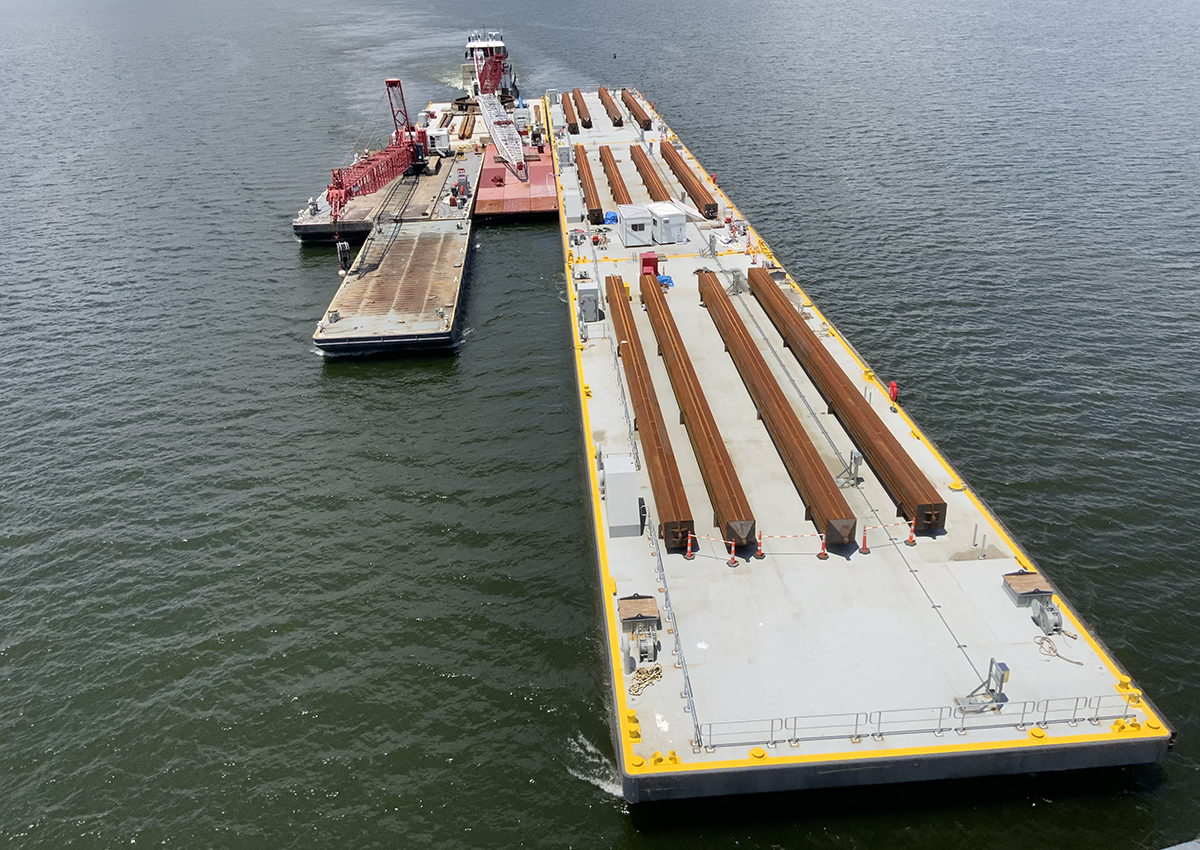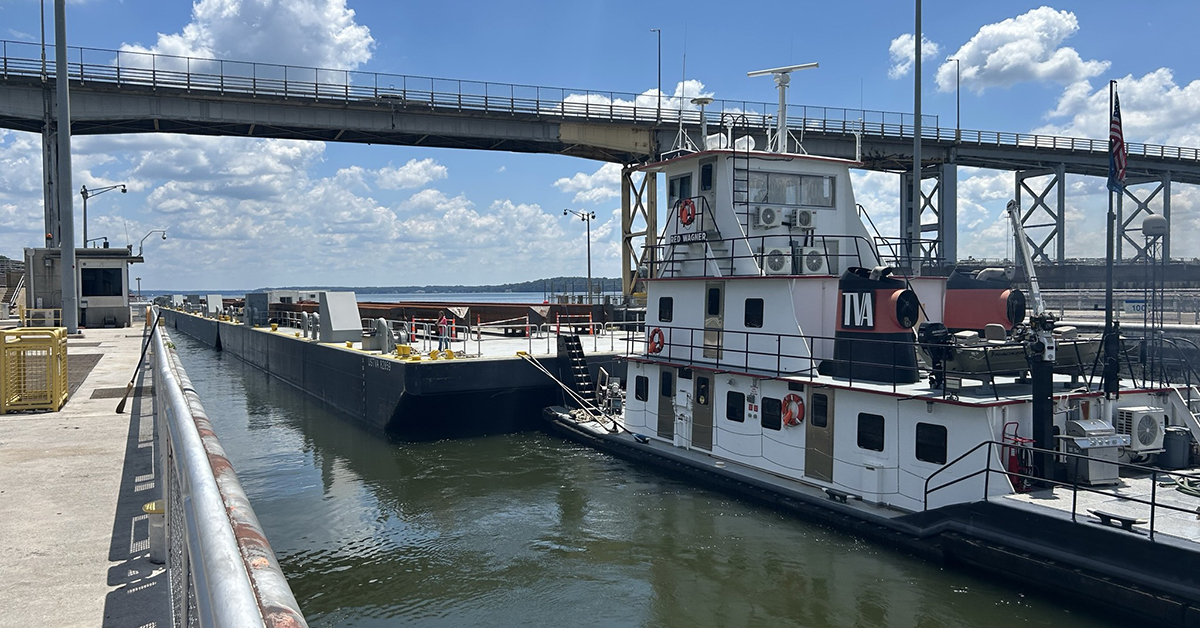A temporary guide wall made from three ocean-going spud barges is being installed at Wilson Locks and Dam on the Tennessee River after Vessel Repair of Port Arthur, Texas, partnered with the Tennessee Valley Authority on the project.
The main navigational lock at Wilson Locks and Dam in Florence, Ala., (Tennessee River Mile 259.4) is closed from July 14 to 28 while the Tennessee Valley Authority installs the interim guide wall. The auxiliary lock is to remain open to navigation throughout the installation.
TVA has contracted with Alberici to install the interim barge wall. TVA will provide construction management oversight, and its Equipment Support Services Group will provide boat services during positioning of the barges. The Nashville Engineer District will continue to manage lock traffic.
Remnants of Hurricane Ida passing through the region August 31, 2021, sank a floating guide wall at Wilson, causing delays in vessel traffic using the main lock. Inspections confirmed there were no safety or environmental impacts to the dam. TVA and the Nashville Engineer District have collaborated since the wall’s sinking to minimize impacts to navigation and the industry. TVA’s Equipment Support Services Group provided helper boat support to commercial vessels to maintain navigation through the lock.
“With more than 11 million tons of goods passing through the Wilson Lock each year, we understand the importance of the lock guide wall to the navigation industry as well as the public,” TVA public relations staff member Adam May said.
While TVA, the Corps of Engineers and industry agreed on the need for a new wall to facilitate locking, designing a replacement was complicated by the sunken wall remaining on the bottom of the Tennessee River, in about 80 feet of water.
Innovative Solution
Shane Carman, manager of river services for TVA, said TVA eventually settled on the idea of three 59-foot by 195-foot spud barges that, when interlocked, form the 585-foot-long wall. Each barge can be spudded down with up to four 120-foot-long spuds that will be sunk into the muddy bottom.

“We knew we needed to have a bigger footprint than the old wall because the old wall is still sunk,” Carman said. “We are leaving that on the bottom of the river.”
In essence, the new wall straddles the sunken one, and it is sturdy enough that tows can rub or slide up against it while lining up to enter the lock, Carman said. The lockmaster may also have tows tie off to it when locking through multiple cuts. The wall serves an important safety function, helping to precisely line up tows to enter the lock and greatly decreasing the possibility of a tow accidentally hitting the dam, which could be catastrophic, he said.
The spud barges are considered an interim solution, designed to last five to 10 years, TVA said in a news release. While the interim wall is being used, TVA intends to continue collaboration with its partners to seek funding for a permanent floating wall that mirrors the design of the original floating wall and includes modernized features.
The urgency of installing the interim guide wall was a major reason the three spud barges were the first tow to lock through Wilson Lock’s main chamber when it reopened July 2 following the completion of repairs to cracks in both downstream miter gates. TVA mobilized near Pickwick Dam on May 12 to outfit the barges with ancillary systems — including lighting, handrails and electrical components to ensure that the barges were ready to be deployed immediately after the lock was opened.
“While we recognize the additional two-week closure following the lock repairs will be an inconvenience for the industry and public, this final phase is critical to ensuring long-term benefits and restoring the lock to normal operations,” May said.
Trusted Partnership
Kurt Moerbe, vice president of Vessel Repair, a shipyard specializing in new construction and repair of towboats and barges, had an existing relationship with TVA, building the mv. Freedom, the first Tier 4 towboat built for a government entity. Additionally, Vessel Repair had also previously worked with Sterling Marine, LLC, which had served as the naval architecture firm on the mv. Freedom project.
Vessel Repair was looking to diversify its portfolio as the building of inland tank barges was down during the COVID-19 pandemic, Moerbe said.
Vessel Repair worked closely with TVA to make sure the barges could meet TVA’s needs now, and in the future, when they will be capable of transporting diversified cargoes, potentially including parts for TVA’s nuclear facilities.
Built To Last
To withstand potential impacts by tows, Vessel Repair built the spud barges out of much heavier, 1-inch-thick deck plate, with web frame spacing only 4 feet from center to center and welds increaed from 5/16 of an inch to 3/8 inch.
The spuds were created from 48-inch rolled plates of high strength steel and wrapped with corner legs 17 inches on each side, also made from high-strength steel, and all x-ray tested. Each spud weighs about 70 tons.
“The spuds themselves cost as much as some vessels we’ve built in the past, so much went into them,” Moerbe said.
Rubber-laminated fendering is laid all the way down the sides and ends. For longevity, it is placed in a way that allows single pieces of damaged fendering to be removed and replaced as necessary without replacing all of it at once, Moerbe said.
The interlocking spud barge wall is designed to be capable of landing 18 dry cargo barges and one towboat.
“They’ve been designed to take quite a bit of an impact,” Moerbe said. “That’s one of the reasons they’re so thick.”
Each barge took roughly nine months to build, with the first delivered to TVA September 30, 2024, the second delivered January 10 and the third delivered March 30.
“They’re made to last a very long time,” Moerbe said.
Building Toward The Future
Construction of the spud barges for TVA is just one of many projects Vessel Repair has undertaken to grow and diversify its facility at Mile 280 of the Gulf Intracoastal Waterway.
The 41-year-old company began building inland tank barges in 2011 and has its own designs and patents on some of the towboats it has built.
In 2020, Vessel Repair added a new 280-foot drydock for its 30,000-barrel tank barge facility along with a two-barge transfer system. Just over two years ago, it added a gas-freeing facility.
Over the past year, Vessel Repair has added another launchway, on which it is currently building deck barges.
“As we pursued new construction, we knew we needed to keep improving and keep adding to make a very efficient facility,” Moerbe said.
The new launchway is only 30 to 40 feet from the main fabrication shop, and it allows launching of vessels up to 300 feet in length, where previously the company was limited to 200 feet in length. As part of the project, the company also sloped and restabilized the riverbank, with ground stabilization and pilework completed in November and December last year.
Just last month, Vessel Repair placed an order for its second, larger building for painting vessels and barges. It will be 325 feet long and 80 feet wide.
“We’re hoping it will be erected by the end of the year,” Moerbe said.
He said the company intends to climate control the painting facilities in the future, which would be unique to the region and allow increased efficiency and a more dependable painting schedule that isn’t impacted by the weather.
Additionally, Vessel Repair is in the process of adding another bay in its fabrication shop, along with new overhead cranes for panel assemblies and laydown of raw materials. The bay is 680 feet long, with 350 feet covered inside the shop. Two 10-ton cranes will operate within it.
Vessel Repair already has two other bays, but adding the third will add efficiencies and the capability of building panels in one and building modules in another, he said. Construction began in May, and he expects it to be complete in the fourth quarter of this year.
Moerbe said the company sees a need for building more tank barges and inland towboats toward the end of this decade and plans to continue growing to meet that need, along with having the capability for selected market-driven projects, such as the spud barges for TVA.
Featured image caption: Three ocean-going spud barges built by Vessel Repair of Port Arthur, Texas, were the first tow through the main navigational chamber at Wilson Lock when it reopened July 2 following repairs. (Photo courtesy of the Tennessee Valley Authority)




